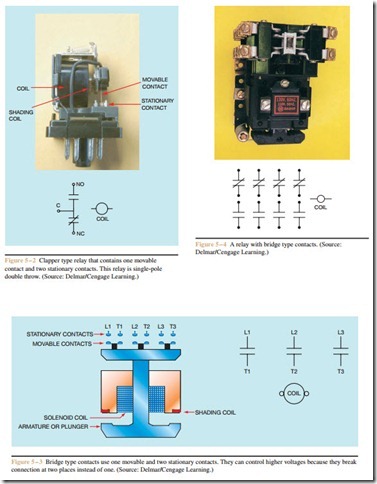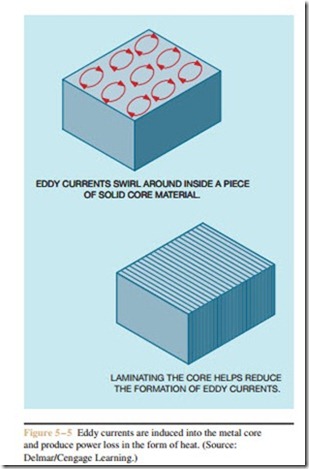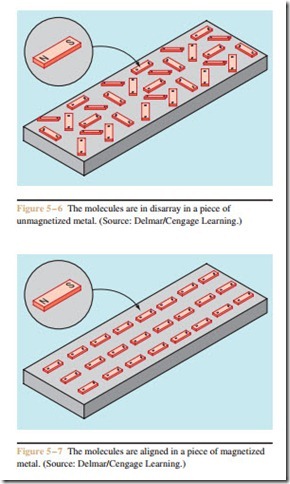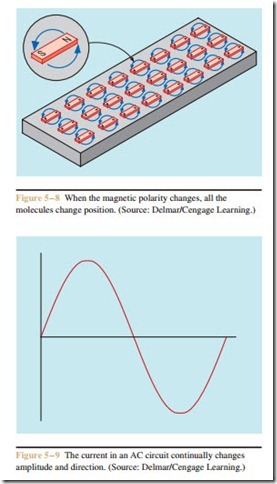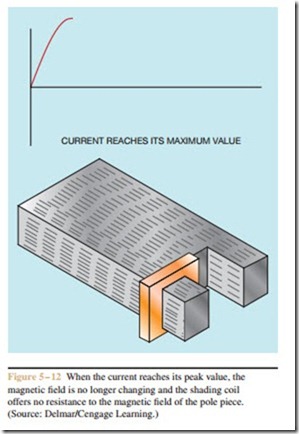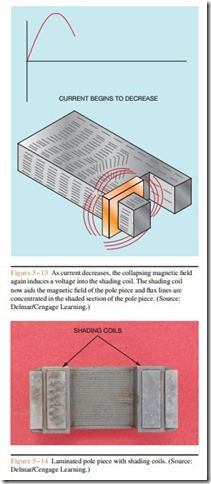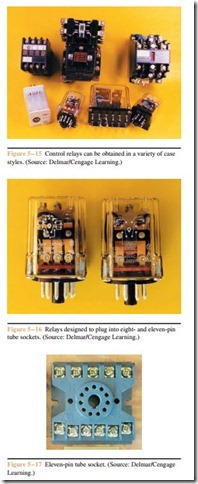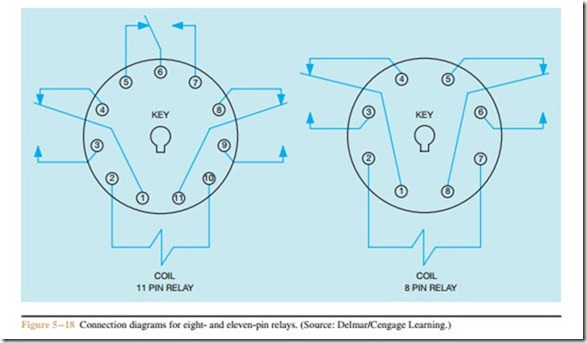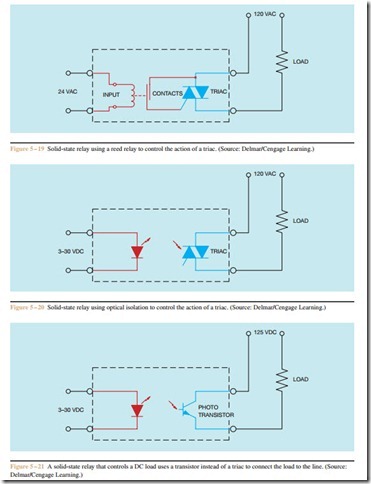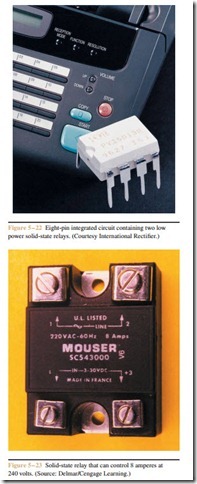Electromagnet Construction
The construction of the electromagnetic part of a relay or contactor greatly depends on whether it is to be operated by direct or alternating current. Relays and contactors that are operated by direct current generally contain solid core materials, while those intended for use with alternating current contain laminated cores. The main reason for the laminated core is the core losses associated with alternating current caused by the continuous changing of the electromagnetic field.
sheets of metal stacked together. A thin layer of oxide forms between the laminations. This oxide is an insula- tor and helps reduce the formation of eddy currents.
magnetic domains are not aligned in any particular order (Figure 5 – 6). If the metal becomes magnetized, the magnetic molecules or domains will align them- selves in an orderly fashion (Figure 5 – 7). If the polar- ity of the magnetic field is reversed, the molecules will realign themselves to the new polarity (Figure 5 – 8). Although the domains will realign to correspond to a change of polarity, they resist the realignment. The power required to cause them to change polarity is a power loss in the form of heat. Hysteresis loss is often referred to as molecular friction because the molecules are continually changing direction in an alternating current field. Hysteresis loss is proportional to the fre- quency. At low frequencies such as 60 hertz, it is gen- erally so small that it is of little concern.
Shading Coils
As mentioned previously, all solenoid type devices that operate on alternating current contain shading coils to prevent chatter. The current in an AC circuit is continually increasing from zero to a maximum value in one direction, returning to zero, and then increasing to a maximum value in the opposite direction (Figure 5 – 9). Since the current is continually falling to zero, the solenoid spring or gravity would continually try to drop the armature out when the magnetic field collapses. Shading coils provide a time delay for the magnetic field to prevent this from happening. As cur- rent increases from zero, magnetic lines of flux concentrate in the metal pole piece (Figure 5 – 10). This increasing magnetic field cuts the shading coil and induces a voltage into it. Since the shading coil or loop is a piece of heavy copper, it has a very low resistance. A very small induced voltage can cause a large amount of current to flow in the loop. The current flow in the shading coil causes a magnetic field to be developed around the shading coil, also. This magnetic field acts in opposition to the magnetic field in the pole piece and causes it to bend away from the shading coil (Figure 5 – 11). As long as the AC current is changing in amplitude, a voltage will be induced in the shading loop.
When the current reaches it maximum, or peak, value, the magnetic field is no longer changing and there is no voltage induced in the shading coil. Since the shading coil has no current flow, there is no magnetic field to oppose the magnetic field of the pole piece (Figure 5 – 12).
When the current begins to decrease, the magnetic field of the pole piece begins to collapse. The collapsing magnetic field again induces a voltage into the shading coil. Since the collapsing magnetic field is moving in the opposite direction, the voltage induced
into the shading coil causes current to flow in the opposite direction, producing a magnetic field of the opposite polarity around the shading coil. The mag- netic field of the shading coil now tries to maintain the collapsing magnetic field of the pole piece (Figure 5 – 13). This causes the magnetic flux lines of the pole piece to concentrate in the shaded part of the pole piece. The shading coil provides a continuous magnetic field to the pole piece, preventing the armature from dropping out. A laminated pole piece with shading coils is shown in Figure 5 – 14.
Control Relay Types
Control relays can be obtained in a variety of styles and types (Figure 5 – 15). Most have multiple sets of contacts, and some are constructed in such a manner that their contacts can be set as either normally open or normally closed. This flexibility can be a great ad- vantage in many instances. When a control circuit is being constructed, one relay may require three nor- mally open contacts and one normally closed, while an- other may need two normally open and two normally closed contacts.
Relays that are designed to plug into eight- or eleven-pin tube sockets are popular for many applica- tions (Figure 5 – 16). These relays are relatively inex- pensive, and replacement is fast and simple in the event of failure. Since the relays plug into a socket, the wiring is connected to the socket, not the relay. Replacement is a matter of removing the defective relay and plugging in a new one. An eleven-pin tube socket is shown in Figure 5 – 17. Eight- and eleven-pin relays can be ob- tained with different coil voltages. Coil voltages of 12 volts DC, 24 volts DC, 24 volts AC and 120 volts AC are common. Their contact ratings generally range from 5 to 10 amperes, depending on relay type and manufac- turer. The connection diagram for eight- and eleven-pin relays is shown in Figure 5 – 18. The pin numbers for eight- and eleven-pin relays can be determined by hold- ing the relay with the bottom facing you. Hold the relay
and 4, 6 and 5, and 11 and 8 are normally closed
contacts. Pins 1 and 3, 6 and 7, and 11 and 9 are normally open contacts. The coil is connected to pins 2 and 10.
The eight-pin relay contains two separate single- pole double-throw contacts. Pins 1 and 4, and 8 and 5 are normally closed. Pins 1 and 3, and 8 and 6 are nor- mally open. The coil is connected across pins 2 and 7.
Solid-State Relays
Another type of relay that is found in many appli- cations is the solid-state relay. Solid-state relays employ the use of solid-state devices instead of mechani- cal contacts to connect the load to the line. Solid-state relays that are intended to connect alternating current loads to the line use a device called a triac. The triac is a bidirectional device, which means that it will permit current to flow through it in either direction. There are a couple of methods used to control when the triac turns on or off. One method employs a small relay de- vice that controls the gate of the triac (Figure 5 – 19). The relay can be controlled by a low voltage source. When energized, the relay contact closes, supplying power to the gate of the triac that connects the load to the line. Another common method for controlling the operation of a solid state relay is called optoisolation,
or optical isolation. This method is used by many PLCs to communicate with the output device. Optoisolation is achieved by using the light from a light-emitting diode (LED) to energize a photo triac (Figure 5 – 20). The arrows pointing away from the diode symbol indi- cate that it emits light when energized. The arrows pointing toward the triac symbol indicate that it must receive light to turn on. Optical isolation is very popu- lar with electronic devices such as computers and PLCs because there are no moving contacts to wear and be- cause the load side of the relay is electrically isolated from the control side. This isolation prevents any elec- trical noise generated on the load side from being trans- ferred to the control side.
Solid-state relays are also available to control loads connected to direct current circuits (Figure 5 – 21). These relays use a transistor instead of a triac to con- nect the load to the line.
Solid-state relays can be obtained in a variety of case styles and ratings. Some have a voltage rating that ranges from about 3 to 30 volts and can control only a small amount of current, while others can control hun- dreds of volts and several amperes. The eight-pin IC (Integrated Circuit) shown in Figure 5 – 22 contains two solid-state relays that are intended for low power appli- cations. The solid-state relay shown in Figure 5 – 23 is
rated to control a load of 8 amperes connected to a 240 volt AC circuit. For this solid-state relay to be capable of controlling that amount of power, it must be mounted on a heat sink to increase its ability to dissipate heat. Although this relay is rated 240 volts, it can also control devices at a lower voltage.
